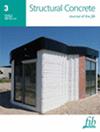含有黄金尾矿作为基层填料的轻质发泡混凝土的性能
IF 3.3
3区 工程技术
Q2 CONSTRUCTION & BUILDING TECHNOLOGY
引用次数: 0
摘要
黄金尾矿是在黄金开采和加工过程中形成的工业废物。本研究的目的是用它来制备泡沫混凝土,作为基层填料。研究了湿密度(600、700 和 800 kg/m3)和尾矿含量(15、30、45 和 60 wt%)对流动性、抗压强度、弹性模量、干燥收缩、抗冻融性、水化热和孔隙结构的影响。结果发现,在发泡混凝土中掺入尾矿会降低抗压强度,因为尾矿会对孔隙结构产生不利影响,导致孔隙率增加、孔隙扩大和连通、球形度降低。为满足基层填料的要求,当设计湿密度为 600 kg/m3 时,尾矿含量限制在 30 wt%;当湿密度增加到 700 和 800 kg/m3 时,尾矿含量限制在 45 wt%。然而,增加尾矿含量可有效减少干燥收缩和龄期水化热,这对大体积发泡混凝土施工十分有利。此外,掺入黄金尾矿还有助于提高 600 和 700 kg/m3 泡沫混凝土的抗冻融性,以便在季节性冰冻地区使用。本文章由计算机程序翻译,如有差异,请以英文原文为准。
Properties of lightweight foamed concrete containing gold tailings as subgrade filler
Gold tailings is formed as an industrial waste during gold mining and processing. The aim of the current study is to use it to prepare foamed concrete as subgrade filler. The effect of wet density (600, 700 and 800 kg/m3 ) and tailings content (15, 30, 45 and 60 wt%) on fluidity, compressive strength, elastic modulus, drying shrinkage, freeze–thaw resistance, hydration heat and pore structure were investigated. It was found that incorporating tailings into foamed concrete decreases the compressive strength as tailings adversely affected the pore structure, resulting in increased porosity, enlarged and connected pores, and reduced sphericity. To meet the requirement of subgrade filler, the tailings content was limited to 30 wt% when the designed wet density was 600 kg/m3 and it was 45 wt% when the wet density increased to 700 and 800 kg/m3 . Nevertheless, increasing the tailings content effectively reduced the drying shrinkage and early age hydration heat which are favorable for massive foamed concrete construction. Besides, the incorporation of gold tailings is helpful to the freeze–thaw resistance of 600 and 700 kg/m3 foamed concrete for application in seasonal frozen areas.
求助全文
通过发布文献求助,成功后即可免费获取论文全文。
去求助
来源期刊

Structural Concrete
CONSTRUCTION & BUILDING TECHNOLOGY-ENGINEERING, CIVIL
CiteScore
5.60
自引率
15.60%
发文量
284
审稿时长
3 months
期刊介绍:
Structural Concrete, the official journal of the fib, provides conceptual and procedural guidance in the field of concrete construction, and features peer-reviewed papers, keynote research and industry news covering all aspects of the design, construction, performance in service and demolition of concrete structures.
Main topics:
design, construction, performance in service, conservation (assessment, maintenance, strengthening) and demolition of concrete structures
research about the behaviour of concrete structures
development of design methods
fib Model Code
sustainability of concrete structures.
 求助内容:
求助内容: 应助结果提醒方式:
应助结果提醒方式:


